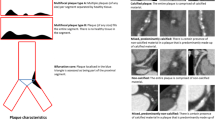Abstract
Objectives
To develop a method for quantitating coronary angiographic abnormalities of segmental size and shape (tapering) in comparison to gender- and segment-specific, population derived, normal values.
Background
In the absence of obvious focal stenoses, remodeling renders the angiogram insensitive to the presence of atherosclerosis and invalidates use of a “normal reference segment” for calculation of percent diameter stenosis.
Methods
Equations were created for detection of size/shape abnormalities of coronary angiographic segments. After validation using intravascular ultrasound (IVUS), the equations were applied to a cohort of segments judged to be completely normal by a panel of highly experienced, core laboratory technicians; and a cohort of patients judged by an experienced interventionalist to have completely normal coronaries.
Results
In patients assessed by core technicians, 53% (162/303) of males, 39% (209/538) of normal segments in males, 60% (56/94) of females, and 40% (81/205) of normal segments in females had quantifiable abnormalities. In patients with normal coronaries as judged by an experienced interventionalist, 100% of males (n = 14) and females (n = 19), 37% (67/182) of segments in males and 43% (105/247) of segments in females had abnormalities. The left main segment was most commonly abnormal.
Conclusions
We propose a set of equations validated using IVUS and based on gender- and segment-specific normal values for coronary angiographic size and shape that markedly improves the sensitivity of the coronary angiogram for detection of abnormalities. The method should replace the unfounded practice of labeling coronary angiograms as “normal” based solely on the failure to detect focal stenoses.









Similar content being viewed by others
References
Glagov S, Weisenberg E, Zarins CK, Stankunavicius R, Kolettis GJ (1987) Compensatory enlargement of human atherosclerotic coronary arteries. N Engl J Med 316:1371–1375
St. Goar FG, Pinto FJ, Alderman EL, Fitzgerald P, Stadius ML, Popp RL (1991) Intravascular ultrasound imaging of angiographically normal coronary arteries: an in vivo comparison with quantitative angioghraphy. J Am Coll Cardiol 18:952–958
Javier SP, Mintz GS, Popma JJ, Pichard AD, Kent KM, Satler LF, Leon MB (1995) Intravascular ultrasound assessment of the magnitude and mechanism of coronary artery and lumen tapering. Am J Cardiol 75:177–180
Mintz G S, Popma JJ, Pichard AD, Kent KM, Satler LF, Wong SC, Hong MK, Kovach JA, Leon MB (1996) Arterial remodeling after coronary angioplasty: a serial intravascular ultrasound study. Circulation 94:35–43
Worthley SG, Helft G, Fuster V, Zaman AG, Fayad ZA, Fallon JT, Badimon JJ (2000) Serial in vivo MRI documents arterial remodeling in experimental atherosclerosis. Circulation 101:586–589
Pasterkamp G, Wensing PJ, Post MJ, Hillen B, Mali WP, Borst C (1995) Paradoxical arterial wall shrinkage may contribute to luminal narrowing of human atherosclerotic femoral arteries. Circulation 91:1444–1449
Nishioka T, Luo H, Eigler NL, Berglund H, Kim CJ, Siegel RJ (1996) Contribution of inadequate compensatory enlargement to development of human coronary artery stenosis: an in vivo intravascular ultrasound study. J Am Coll Cardiol 27:1571–1576
Mintz GS, Kent KM, Pichard AD, Satler LF, Popma JJ, Leon MB (1997) Contribution of inadequate arterial remodeling to the development of focal coronary artery stenoses: an intravascular ultrasound study. Circulation 95:1791–1798
Britten MB, Zeiher AM, Schachinger V (2003) Effects of cardiovascular risk factors on coronary artery remodeling in patients with mild atherosclerosis. Coron Art Dis 14:415–422
DeScheerder I, DeMan F, Herregods MC, Wilczek K, Barrios L, Raymenants E, Desmet W, DeGeest H, Piessens J (1994) Intravascular ultrasound versus angiography for measurement of luminal diameters in normal and diseased coronary arteries. Am Heart J 127:243–251
Moussa I, Kobayashi Y, Adamian M, Hirose M, DeMario C, Moses J, Colombo A (2001) Characteristics of patients with a large discrepancy in coronary artery diameter between quantitative angiography and intravascular ultrasound. Am J Cardiol 88:294–296
Asakura T, Karino T (1990) Flow patterns and spatial distribution of atherosclerotic lesions in human coronary arteries. Circ Res 66:1045–1066
Zubaid M, Buller C, Mancini GBJ (2002) Normal angiographic tapering of the coronary arteries. Can J Cardiol 18:973–980
MacAlpin RN, Abbasi AS, Grollman JH, Eber L (1973) Human coronary artery size during life. Radiology 108:567–576
Dodge JT, Brown BG, Bolson EL, Dodge HT (1992) Lumen diameter of normal human coronary arteries: influence of age, sex, anatomic variation, and left ventricular hypertrophy or dilation. Circulation 86:232–246
Leung W-H, Alderman EL, Lee TC, Stadius ML (1995) Quantitative arteriography of apparently normal coronary segments with nearby or distant disease suggests presence of occult, nonvisualized atherosclerosis. J Am Coll Cardiol 25:311–317
Pitt B, Byington RP, Furberg CD, Hunninghake DB, Mancini GBJ, Miller ME, Riley W (2000) Effect of amlodipine on the progression of atherosclerosis and the occurrence of clinical events. Circulation 102:1503–1510
Principal Investigators of CASS, their associates. (1981) The national heart, lung and blood institute coronary artery surgery study (CASS). Circulation 63(Suppl I):1–40
Seiler C, Kirkeeide RL, Gould KL (1992) Basic structure-function relations of the epicardial coronary vascular tree: basis of quantitative coronary arteriography for diffuse coronary artery disease. Circulation 85:1987–2003
Seiler C, Kirkeeide RL, Gould KL (1993) Measurement from arteriograms of regional myocardial bed size distal to any point in the coronary vascular tree for assessing anatomic area at risk. J Am Coll Cardiol 21:783–797
Laslett L (1995) Normal left main coronary artery diameter can be predicted from diameters of its branch vessels. Clin Cardiol 18:580–582
Gould KL, Nakagawa Y, Nakagawa K, Sdringola S, Hess MJ, Haynie M, Parker N, Mullani N, Kirkeeide R (2000) Frequency and clinical implications of fluid dynamically significant diffuse coronary artery disease manifest as graded, longitudinal, base-t-apex myocardial perfusion abnormalities by noninvasive positron emission tomography. Circulation 101:1931–1939
De Bruyne B, Hersbach F, Pijls NHJ, Bartunek J, Bech J-W, Heyndrickx GR, Gould KL, Mijns W (2001) Abnormal epicardial coronary resistance in patients with diffuse atherosclerosis but “normal” coronary angiography. Circulation 104:2401–2406
Windecker S, Allemann Y, Billinger M, Pohl T, Hutter D, Orsucci T, Blaga L, Meier B, Seiler C (2002) Effect of endurance training on coronary artery size and function in healthy men: an invasive followup study. Am J Physiol Heart Circ Physiol 282:H2216–H2223
Isner JM, Kishel J, Kent KM, Ronan JA, Ross AM, Roberts WE (1981) Accuracy of angiographic determination of left main coronary arterial narrowing. Angiographic-histologic correlative analysis in 28 patients. Circulation 63:1056–1064
Lewis BS, Gotsman MS (1973) Relation between coronary artery size and left ventricular wall mass. Br Heart J 35:1150–1153
Kucher N, Lipp E, Schwerzmann M, Zimmerli M, Alleman Y, Seiler C (2001) Gender differences in coronary artery size per 100 g of left ventricular mass in a population without cardiac disease. Swiss Med Week 131:610–615
Tan TH, Wong KY, Cheng TK, Heng JT (2003) Coronary normograms and the coronary-aorta indes: Objective determinants of coronary artery dilatation. Pedatr Cardiol 24:328–335
Jiang B, Godfrey KM, Martyn CN, Gale CR (2006) Birth weight and cardiac structure in children. Pediatrics 117:257–261
Dhawan J, Bray CL (1995) Are Asian coronary arteries smaller than Caucasian? A study on angiographic coronary artery size estimation during life. Int J Cardiol 49:267–269
Kaimkhani Z, Ali M, faruqui AMA (2004) Coronary artery diameter in a cohort of adult Pakistani population. J Pak Med Assoc 54:258–261
DaCosta A, Isaaz K, Faure E, Mourot S, Cerisier A, Lamaud M (2001) Clinical characteristics, aetiological factors and long-term prognosis of myocardial infarction with an absolutely normal coronary angiogram: a 3 year follow-up of 91 patients. Eur Hear J 22:1459–1465
Makaryus AN, Dhama B, Raince J, Raince A, Garyali S, Labana SS, Kaplan BM, Park C, Jauhar R (2005) Coronary artery diameter as a risk factor for acute coronary syndromes in Asian–Indians. Am J Cardiol 96:778–780
O’Connor NJ, Morton JR, Birkmeyer JK, Olmstead EM, O’Connor GT (1996) Effect of coronary artery diameter in patients undergoing coronary bypass surgery. Circulation 93:652–655
Shah PJ, Gordon I, Fuller J, Seevanayagam S, Rosalion A, Tatoulis J, Raman JS, Buxton BF (2003) Factors affecting saphenous vein graft patency: Clinical and angiographic study in 1,402 symptomatic patients operated on between 1977 and 1999. J Thorac Cardiovasc Surg 126:1972–1977
Christakis GT, Weisel RD, Buth KJ, Fremes SE, Rao V, Panagiotopoulos KP, Ivanov J, Goldman BS, David TE (1995) Is body size the cause for poor outcomes of coronary artery bypass operations in women? J Thorac Cardiovasc Surg 110:1344–1358
Eysmann SB, Douglas PS (1992) Reperfusion and revascularization strategies for coronary artery disease in women. JAMA 268:1903–1907
Author information
Authors and Affiliations
Corresponding author
Rights and permissions
About this article
Cite this article
Mancini, G.B.J., Ryomoto, A., Kamimura, C. et al. Redefining the normal angiogram using population-derived ranges for coronary size and shape: validation using intravascular ultrasound and applications in diverse patient cohorts. Int J Cardiovasc Imaging 23, 441–453 (2007). https://doi.org/10.1007/s10554-006-9199-z
Received:
Accepted:
Published:
Issue Date:
DOI: https://doi.org/10.1007/s10554-006-9199-z




